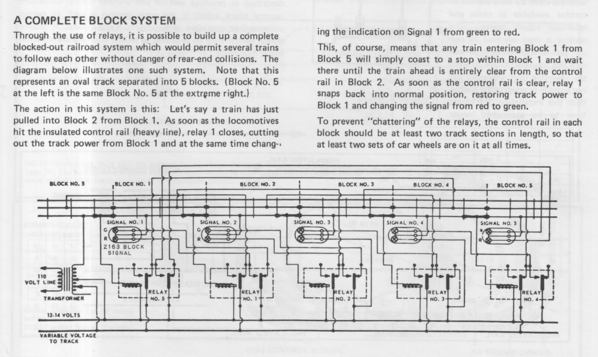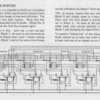Good morning everyone, i like to run my trains the old fashioned way , with automated stop and start block wiring, problem is, i don`t know how to do wire something like that, can anyone draw a simple diagram for me to follow, any and all help would be greatly appreciated, thanks to you all, keep them trains a`runnin.....
Replies sorted oldest to newest
You can use an automatic block control system that has been used by Lionel operators for over 70 years:
Attachments
I highly recommend picking up copies of Greenberg's Wiring Your Lionel Layout, by Peter Riddle, Vols 1 & 2. These books answered most, if not all, of my questions when starting out. They cover block wiring as well as control of various operating accessories, with plenty of easy-to-read track diagrams.
Thanks ADCX ROB and you too GERMAN, i`ll try both of your suggestions , hopefully, i won`t fry myself, lol
Even though we run 99.9% DCS, my layout is wired the "old fashion way."
Why? Flexibility and Strategy. Flexibility: you can RUN multiple units of old equipment.
Most importantly: strategy! WHEN, notice I didn't say if, WHEN you experience an electrical issue it is EASY to track down because the track is "divided" into multiple electrical Blocks.
Our layout covers a 1300 square foot plus basement. There are approximately fifty (50) Blocks (isolated sections) of track. WHEN the issue(s) occurs, I simply walk around the layout and place my ATLAS SELECTORS slide buttons into the "center"--off position.
Then I watch my transformers closely focusing on the indicator light. When it flashes red, there is a short-circuit. I turn on my Blocks, one by one, keeping an eye waiting for the red flashing to begin. This method of tracing/tracking down a short-circuit makes it EASY as EASY can be to locate a problem. My Blocks are no longer than 20 to 25 feet in length.
Shortly, I am making a video demonstrating/explaining how to wire a 3 rail layout into multiple Blocks including including DCS in the set-up--you don't have to use DCS.
Everyone, everyone should continue to divide their layouts into BLOCKS because it makes it simple to locate electrical gremlins that absolutely will occur even on the best planned layouts.
Watch for the video............
ADCX Rob posted:
with modern production, do locomotives still "coast to a stop" ?
Attachments
It depends on the locomotive. Some flywheels are better than others. I find that my HO and N flywheels generally had better performance on coasting than the ones in my O scale locomotives. Vertical drive locomotives without flywheels don't coast at all. How do I know? Experience with some older Williams and Weaver locomotives coming to a dead stop when the power was cut and sending cars flying all over the place!
German posted:I highly recommend picking up copies of Greenberg's Wiring Your Lionel Layout, by Peter Riddle, Vols 1 & 2. These books answered most, if not all, of my questions when starting out. They cover block wiring as well as control of various operating accessories, with plenty of easy-to-read track diagrams.
This book might be very hard to find it's been out of print for a long time and the last time I was looking at them they were very very high in price. Excellent books though. Give it a shot you might get lucky and find a few out there for a good price.
thanks to you all, i`ll try them all and see which works best, the layout is finished, will post some pics and a video so you can all see it
GG1 4877 posted:It depends on the locomotive. Some flywheels are better than others. I find that my HO and N flywheels generally had better performance on coasting than the ones in my O scale locomotives. Vertical drive locomotives without flywheels don't coast at all. How do I know? Experience with some older Williams and Weaver locomotives coming to a dead stop when the power was cut and sending cars flying all over the place!
i'm sure i've read somewhere that this has a lot to do with the pitch of the worm gear. whenever you need to turn the axis of rotation, there is usually a worm gear involved.
'I will second the block comment. My layout is a tad on the large side with about 130 blocks covering 6 power districts. Any short can be found in less than 5 minutes. No non toggled power feeds.
You WILL have shorted circuits and other electrical Murphys..
E-UNIT-79 posted:German posted:I highly recommend picking up copies of Greenberg's Wiring Your Lionel Layout, by Peter Riddle, Vols 1 & 2. These books answered most, if not all, of my questions when starting out. They cover block wiring as well as control of various operating accessories, with plenty of easy-to-read track diagrams.
This book might be very hard to find it's been out of print for a long time and the last time I was looking at them they were very very high in price. Excellent books though. Give it a shot you might get lucky and find a few out there for a good price.
Peter Riddle has a newer wiring book out called 'Wiring Your Toy Train Layout'. I read it a few years ago and thought it was pretty good. It explains quite a bit and gives a good basic idea of wiring a layout. To me it was well written and easy to understand. I have not seen the Greenberg versions, but the newer one here may be similar to those? I have looked for the Greenberg versions and they are hard to find and if you do find them they are usually pretty expensive.
When you get to actually buying the relays I'd be curious what the current thinking is on using what I'd think are more readily available (possibly less expensive?) DC-coil relays.
What if instead of turning off the block we reduced the power level, so that the train slowed down rather than stopped. Maybe as it gets further into the block power would be turned off, simulating prototype stopping. More complex relays and sensors.
Is this a one way mainline? More complex if two way?
Bill
Not just reducing the power level but stepping or sequencing the voltage down and up can improve visual appeal. Coasting is typically over in a couple seconds whereas momentum control (common in better HO DC transformers) can accelerate and decelerate engines over many seconds. This also eliminates the so-called jack-rabbit starts so an engine slowly comes up to speed over many seconds rather than a few seconds if blocks are controlled with a simple on/off relay. This is another example where using DC-coil relays (12V DC in particular) can have its place since there are many low-cost timer and related modules that can effect more than simple on or off voltage to a block.
12V DC relays assembled with screw terminals for easy wiring go for less than $1 each. I don't know if the books/references discussed above address what I'd call the "phenomenon" of low-cost DC relays and control modules from eBay, Amazon, etc.. It brings new life to conventional control.








